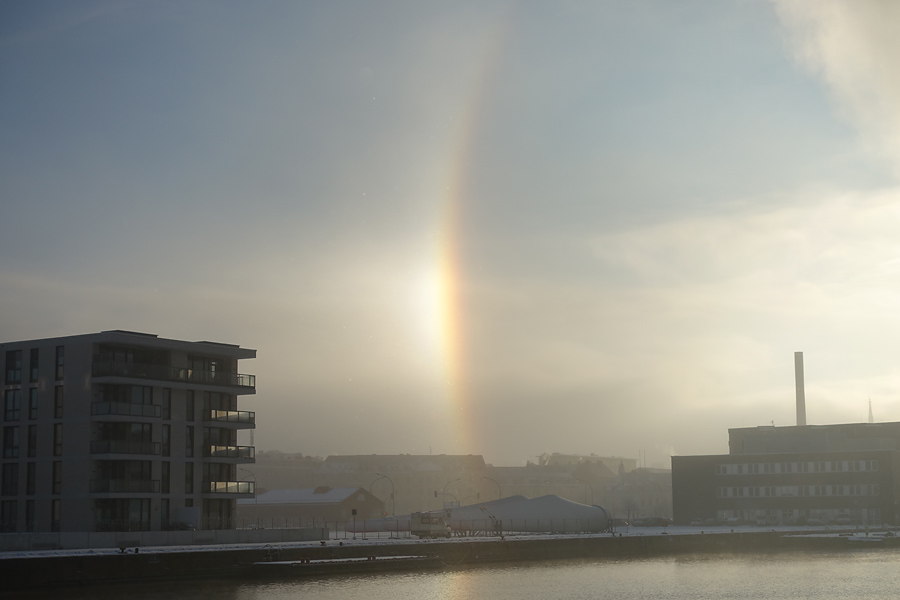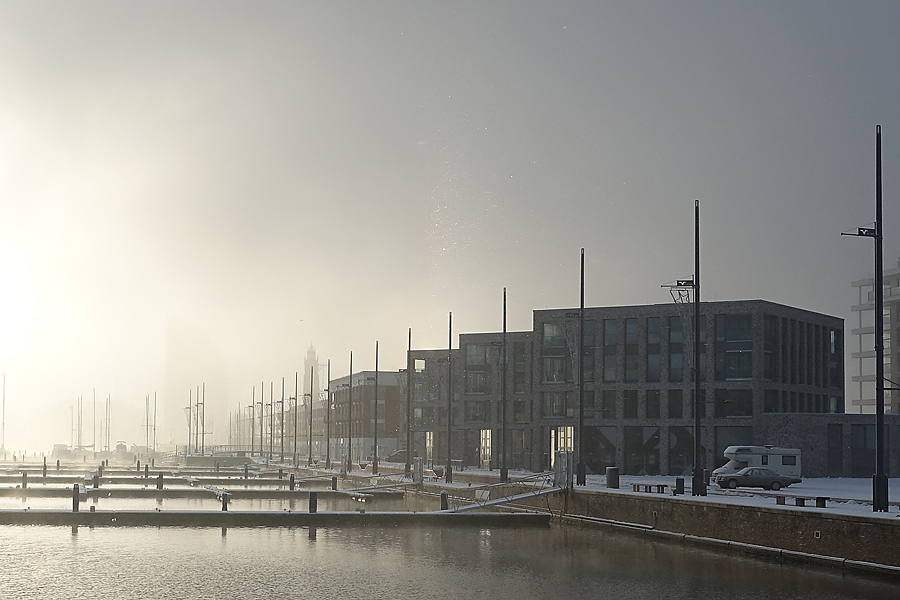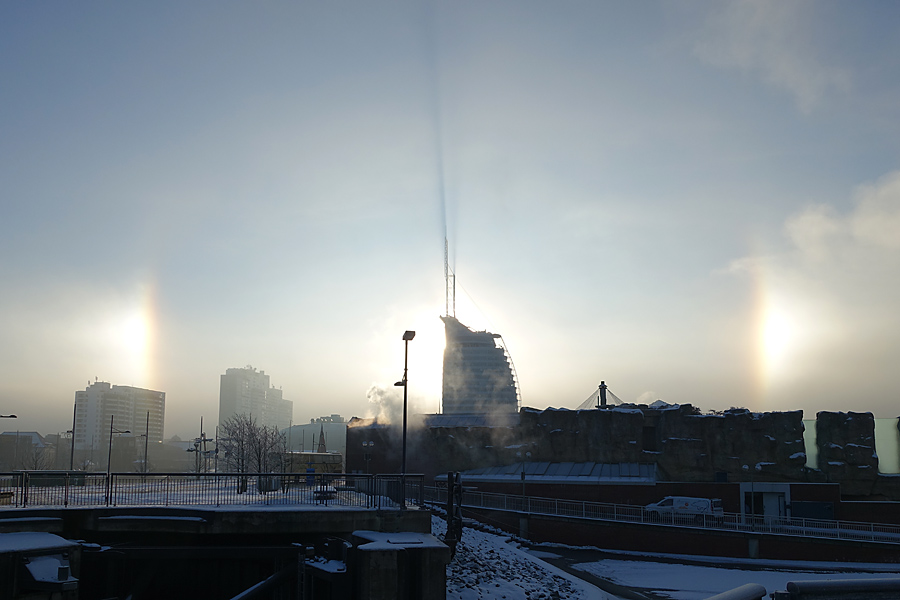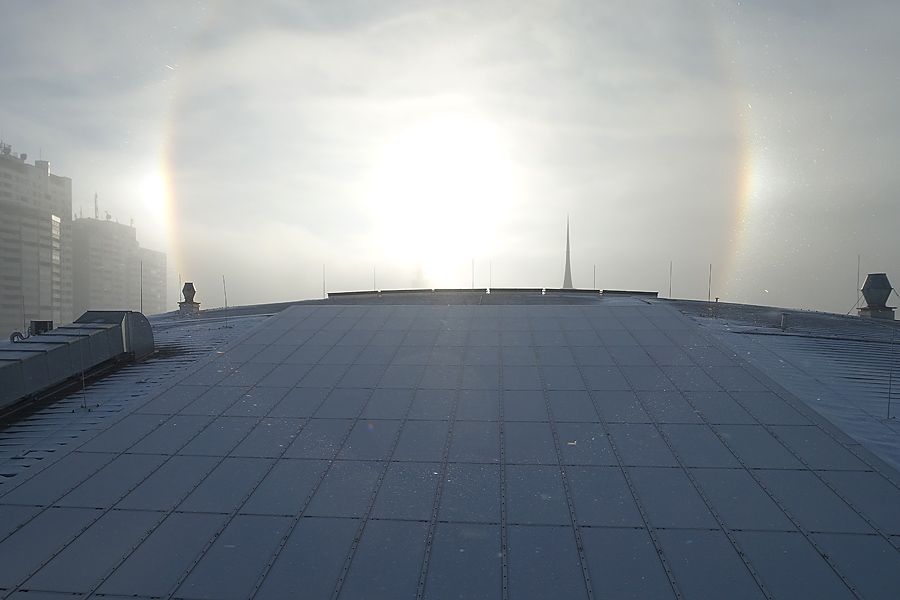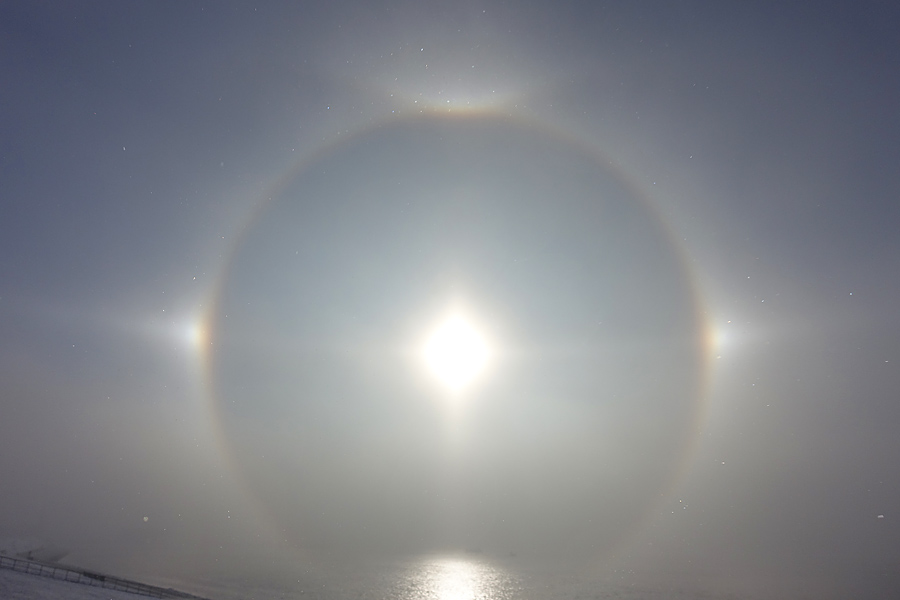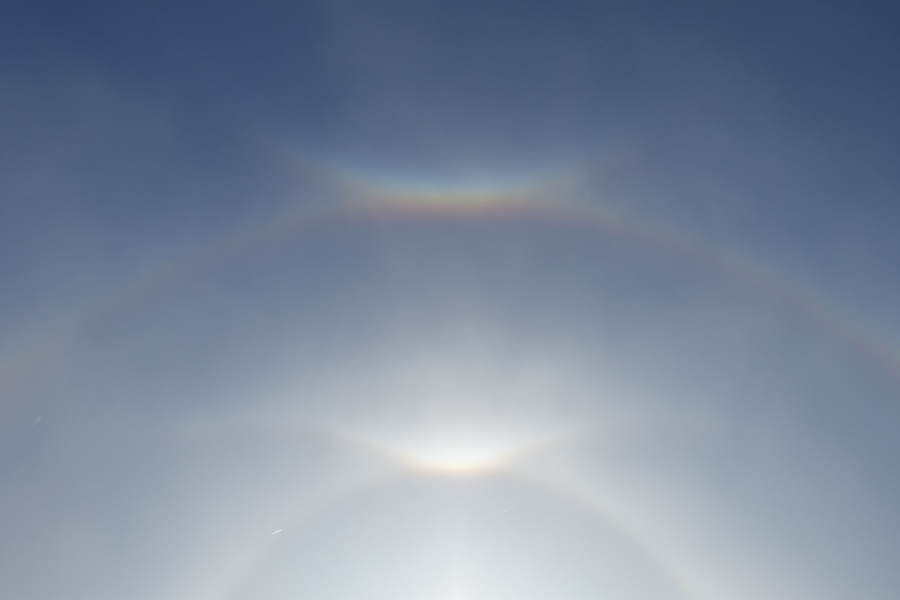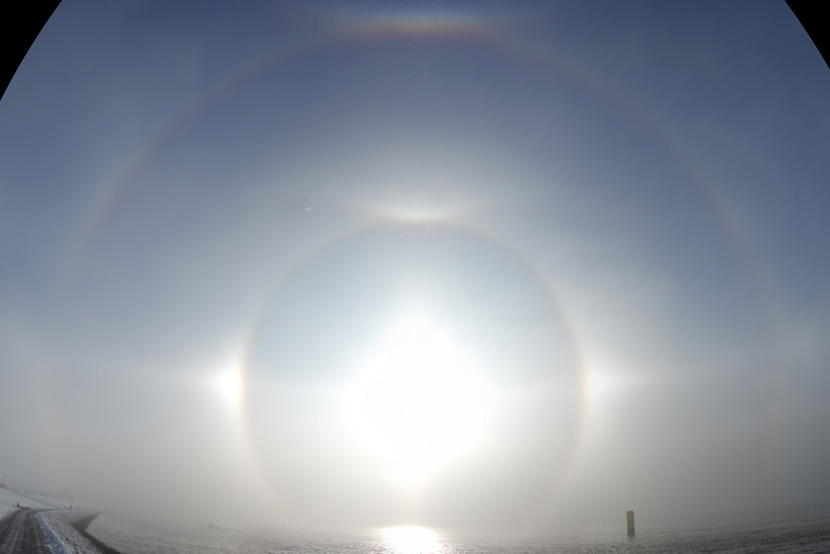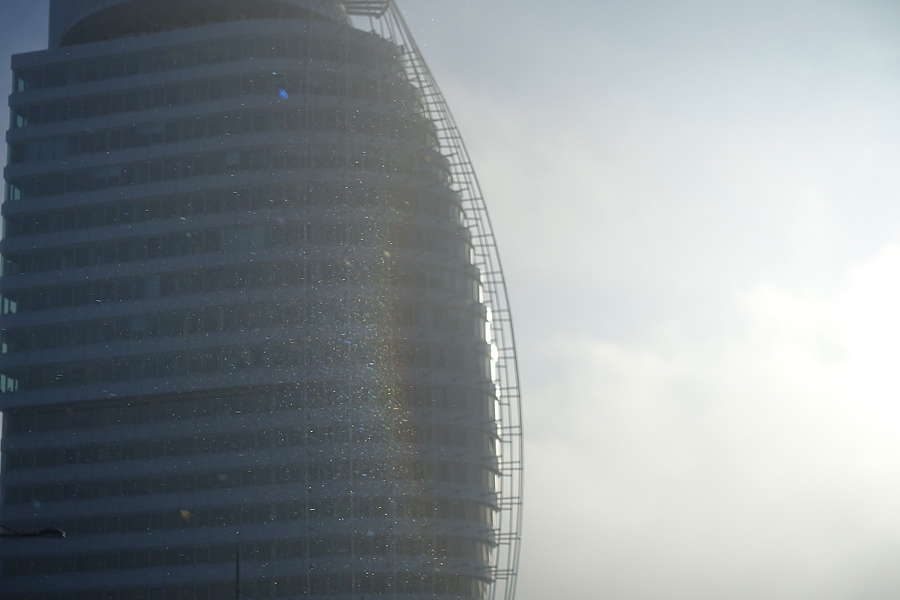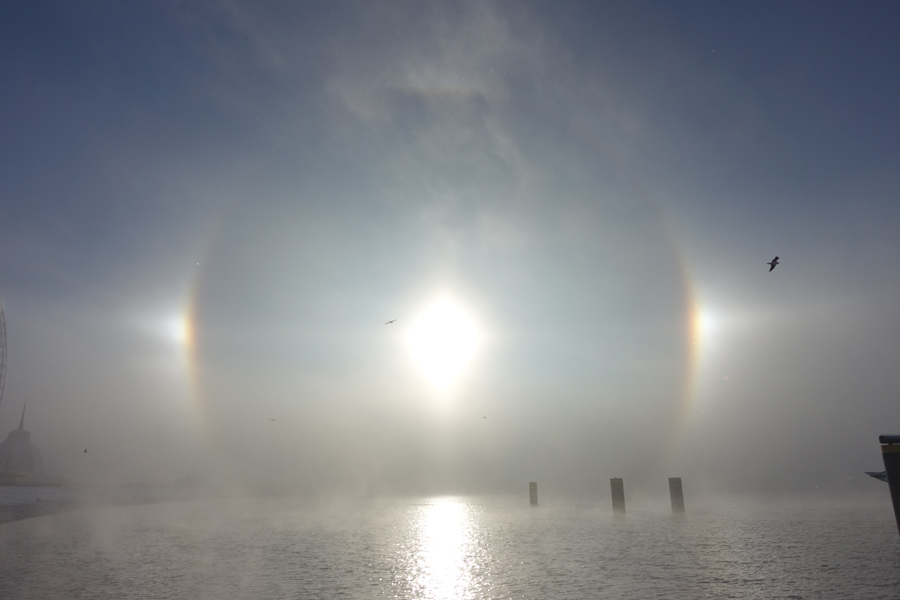Ice Fog Halos in Bremerhaven, North Sea
Observer: Michael Theusner, Bremerhaven
Date: 21.01.2016
A very impressive halo phenomenon in ice fog could be observed in Bremerhaven from the morning to the early afternoon of 21.01.16. I was able to visually detect the following halo types.
Phenomena
- EE01 - 22° Ring
- EE04 - Both Parhelia (sometimes very bright)
- EE05 - Upper Tangent Arc
- EE06 - Lower Tangent Arc
- EE08 - Upper Sun Pillar
- EE09 - Lower Sun Pillar
- EE11 - Circumzenithal Arc
- EE12 - 46° Ring
- EE13 - Horizontal Circle (near the sun, up to about 90° to the right of the sun)
- EE21 - Supralateral Arc
- EE27 - Parry Arc
- EE57 - Tricker's Anthelion Arc
Proven through image processing
- EE61 - Solar Arc (inside the 22° ring)
- EE77 - Moilanen Arc
The fog had formed the evening before and impaired the view of the aurora on 20.01.16. The lowest temperature in the morning at the DWD measuring station at the harbor (very close to the observation site) was -8.6°C, rising to a maximum of -6.0 °C by the afternoon. The halos were not visible throughout the entire period. When denser banks of fog passed through and obscured the sun, they disappeared. Also, due to my job, I couldn't observe the whole time. The peak of the halo phenomenon that I recorded was between 12:45 and 13:00.
I noticed the ice fog halos around 9:45 on my way to work in the area of the New Harbor in Bremerhaven. There near the Weser, the fog suddenly cleared, and the sun came out. When I crossed the folding bridge of Schleusenstraße, I suddenly saw to my left in the fog an extremely bright, left sun dog, and parts of the 22° ring. My first thought: ice fog halos in Bremerhaven! So I stopped immediately, took out my camera (Sony DSC-RX100M3), and took photos.
Shortly afterward, a wall of fog approached, and the halos gradually disappeared. The sun dogs turned into pale remnants, each consisting only of individual, sparkling crystals until they were completely gone.
So I was able to park the car calmly and set off on foot to my workplace, which normally takes less than 10 minutes. However, on this 21st of January, it took noticeably longer.
On the way, halos appeared again. The sun had come out again and two very bright sun dogs appeared. In addition, there were shadow rays through the Atlantic Hotel. The fog then became denser, and the 22° halo and the circumzenithal arc became visible (around 10 a.m.).
On the roof of my workplace (10:15 to 10:20), I took the next pictures. The ice fog was now so dense that ice crystals were flying all around me, and I could see the halos practically right in front of me (Video of it). Even between me and the camera, crystals of the 22° halo sparkled when I held the black camera extended in front of me. I had never experienced anything like that before. The sparkling below the 22° halo is most likely the Lower Tangent Arc.
Back down at the dike (from 10:20) in front of the shopping center "Mediterraneo", a fantastic view of ice fog halos was offered again. Everywhere in the air, it sparkled, and the halos had clearly gained in brightness. Now, in addition to the sundogs and 22° halo, upper and lower light pillars, upper tangent arc, and parts of the parhelic circle about ±40° around the sun were also very well visible.
Additionally, there was a very beautiful circumzenithal arc and a weak 46° ring / supralateral arc.
Around 10:35, the overall view was composed of three images stitched into a panorama (Willy-Brand-Platz with Emigrant Monument):
After 10:45, the next fog bank followed for 10 minutes, covering the sun. Then it continued with ice fog halos with rapidly changing brightness. Again and again, I found myself directly in the cloud of ice crystals, making the halos seem within reach. This phase lasted until 11:10. After that, dense fog followed without halos.
It was not until 12:45 that I noticed greater halo activity again, which became even more impressive than that of the morning. All the halo forms described above could be seen simultaneously. This phase lasted only 15 minutes. Then followed halo-less, dense fog, which increasingly turned into thick high fog, in which no halos appeared either.
Finally, just before it clouded over, Tricker's anthelic arc was also faintly visible at the antisolar point. The lower images show a single image on the left and the average of three photos on the right (with additional contrast enhancement), in which it is even more visible. I had never been able to observe Tricker's anthelic arc before.
With subsequent image editing, the Moilanen arc is likely to become visible as well. This can be detected through unsharp masking in three images, all taken around 12:55. At this time, the halos were brightest. In order, there is an unedited single image below (where it may already be guessed), followed by two (averages from the three questioned images) with simple and double unsharp masking, as well as one with a verified Moilanen arc (by Petr Kousal) as a reference. Simultaneously, the solar arcs are still faintly visible in the edited images, intersecting at the sun.
Summary
Conclusion: A halo phenomenon in ice fog is quite an exception on the North Sea, with its generally milder temperatures. I experienced something similar only in November at the Halo Meeting in Boží Dar , but not even there in this manifestation (missed daytime halos on Friday due to late arrival).
Not only did I notice the halos. While I was on the dike, I repeatedly noticed people also taking photos. Some residents of the seaside town became aware of the halos due to their brightness and photographed them. Some of these photos can be accessed via the Facebook page of the Klimahaus, where they have been shared.
The next day, a note with pictures explaining the halo phenomenon also appeared in the Nordseezeitung. For this, the Nordseezeitung used an explanatory text that I had cautiously sent to them in the afternoon.
In my life, I have never experienced such a halo phenomenon and will probably not see ice fog halos in Bremerhaven or elsewhere in the North German lowlands again soon.

